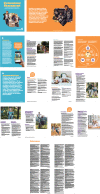Development of a consensus statement on the role of the family in the physical activity, sedentary, and sleep behaviours of children and youth
- PMID: 32539730
- PMCID: PMC7296673
- DOI: 10.1186/s12966-020-00973-0
Development of a consensus statement on the role of the family in the physical activity, sedentary, and sleep behaviours of children and youth
Abstract
Background: Children and youth who meet the physical activity, sedentary, and sleep behaviour recommendations in the Canadian 24-Hour Movement Guidelines are more likely to have desirable physical and psychosocial health outcomes. Yet, few children and youth actually meet the recommendations. The family is a key source of influence that can affect lifestyle behaviours. The purpose of this paper is to describe the process used to develop the Consensus Statement on the Role of the Family in the Physical Activity, Sedentary, and Sleep Behaviours of Children and Youth (0-17 years) and present, explain, substantiate, and discuss the final Consensus Statement.
Methods: The development of the Consensus Statement included the establishment of a multidisciplinary Expert Panel, completion of six reviews (three literature, two scoping, one systematic review of reviews), custom data analyses of Statistics Canada's Canadian Health Measures Survey, integration of related research identified by Expert Panel members, a stakeholder consultation, establishment of consensus, and the development of a media, public relations, communications and launch plan.
Results: Evidence from the literature reviews provided substantial support for the importance of family on children's movement behaviours and highlighted the importance of inclusion of the entire family system as a source of influence and promotion of healthy child and youth movement behaviours. The Expert Panel incorporated the collective evidence from all reviews, the custom analyses, other related research identified, and stakeholder survey feedback, to develop a conceptual model and arrive at the Consensus Statement: Families can support children and youth in achieving healthy physical activity, sedentary and sleep behaviours by encouraging, facilitating, modelling, setting expectations and engaging in healthy movement behaviours with them. Other sources of influence are important (e.g., child care, school, health care, community, governments) and can support families in this pursuit.
Conclusion: Family is important for the support and promotion of healthy movement behaviours of children and youth. This Consensus Statement serves as a comprehensive, credible, and current synopsis of related evidence, recommendations, and resources for multiple stakeholders.
Keywords: Guardian; Health; Parent; Parenting practices; Physical activity; Role model; Rules; Sedentary behaviours; Sibling; Sleep; Structure; Support.
Conflict of interest statement
MST is the Chief Scientific Officer for the ParticipACTION Report Card and the Scientific Chair for the Consensus Statement. He receives no personal compensation for these roles but the Children’s Hospital of Eastern Ontario Research Institute receives funding from ParticipACTION for the Healthy Active Living and Obesity Research Group to lead the development of the Report Card and Consensus Statement. LCM received salary support from the BC Children’s Hospital Research Institute. LMV is employed by ParticipACTION (serving as the organization’s Knowledge Translation Manager) holds a CIHR Fellowship Award. All other authors (RER, MDG, KB, CSB, JPC, GF, IJ, SM, TLM, MP, KS, JS, NS, KAT, JRT, HW, FW) declare they have no competing interests.
Figures



References
-
- Tremblay MS, Carson V, Chaput J-P, Connor Gorber S, Dinh T, Duggan M, et al. Canadian 24 hour movement guidelines for children and youth: an integration of physical activity, sedentary behaviour, and sleep. Appl Physiol Nutr Metab. 2016;41(6 Suppl 3):S311–S327. - PubMed
-
- Saunders TJ, Gray CE, Poitras VJ, Chaput JP, Janssen I, Katzmarzyk PT, et al. Combinations of physical activity, sedentary behaviour and sleep: relationships with health indicators in school-aged children and youth. Appl Physiol Nutr Metab. 2016;41(6 Suppl 3):S283–S293. - PubMed
-
- Poitras VJ, Gray CE, Borghese MM, Carson V, Chaput JP, Janssen I, et al. Systematic review of the relationships between objectively measured physical activity and health indicators in school-aged children and youth. Appl Physiol Nutr Metab. 2016;41(6 Suppl 3):S197–S239. - PubMed
-
- Chaput JP, Gray CE, Poitras VJ, Carson V, Gruber R, Olds T, et al. Systematic review of the relationships between sleep duration and health indicators in school-aged children and youth. Appl Physiol Nutr Metab. 2016;41(6 Suppl 3):S266–S282. - PubMed

